- Nike has had a volatile year and the shares are down 11.8% YTD
- The valuation is high
- Wall Street consensus is bullish, with about 25% expected 12-month gain
- The market-implied outlook for NKE is slightly bullish to the middle of 2022 but slightly bearish for the full year
I recall reading, long ago, that Nike (NYSE:NKE) is best described as a marketing firm that sells shoes rather than a shoe company. The company has created a host of internationally-known products and marketing campaigns for many years.
At the end of 2021, NKE moved further away from the physical business of shoe and apparel production by purchasing RTFKT, a company that designs and sells virtual sneakers for the metaverse as well as producing shoe-related NFTs.
The Nike share price has moved dramatically over the past 12 months, from $140 at the start of 2021 to a 12-month low of $127.1 in April, and then shooting up to a close of $173.85 on Aug. 5. The high close for 2021 was $177.51 on Nov. 5.
The precipitous share price gains began in June after Nike reported very strong FY Q4 earnings on June 14—Q4 EPS were 82.7% above analyst expectations (Source: E-Trade).
By mid-September, the shares had dropped substantially from their YTD highs, but then NKE turned in another earnings beat (albeit a small one) for FY Q1 on Sept. 23, which spurred the price to hit the 2021 high close. The shares have fallen 11.8% so far this year.
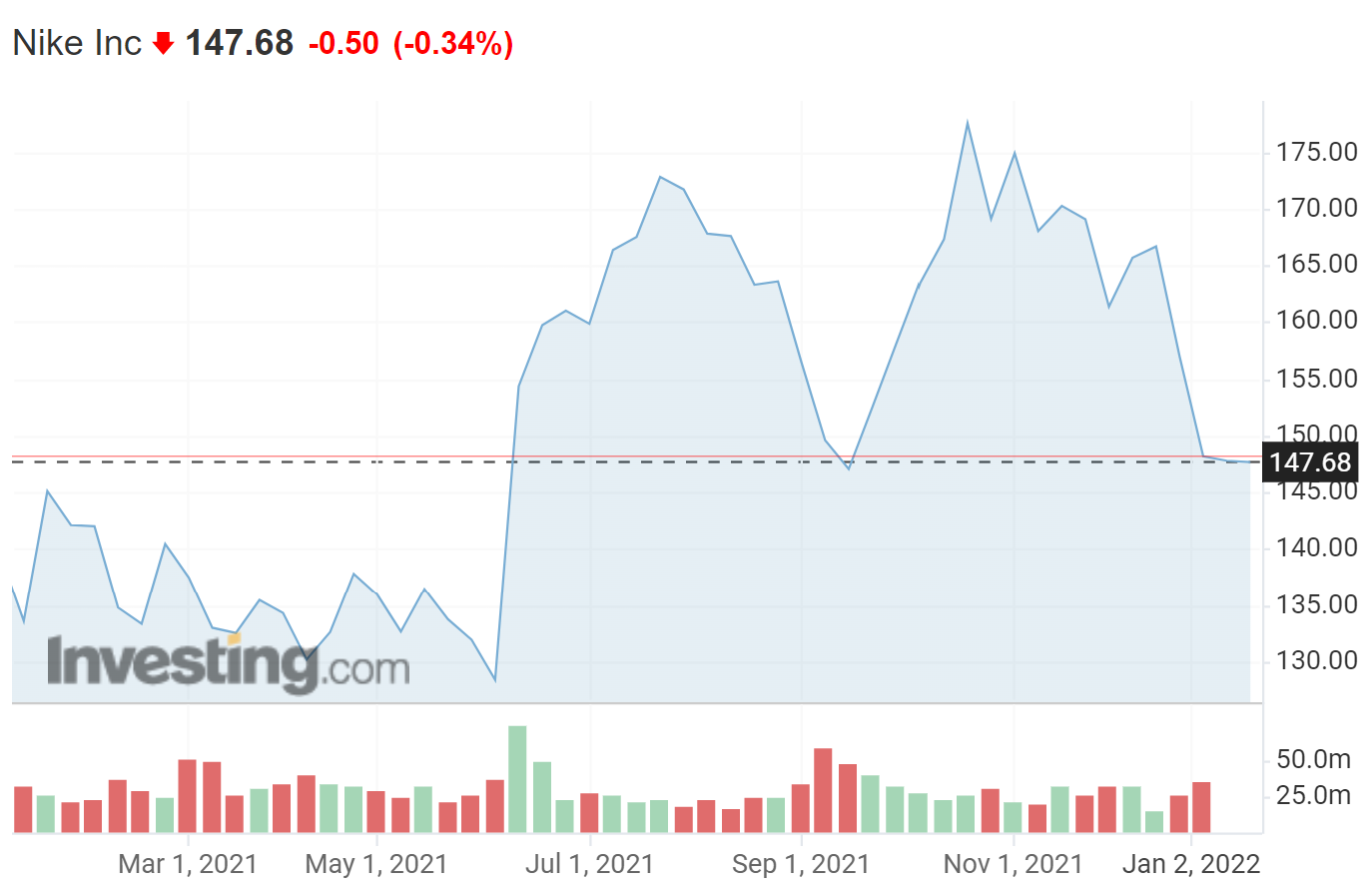
Source: Investing.com
Nike is obviously very sensitive to emerging news and, with the high valuation of 39x the shares are likely to have some interest rate exposure as well.
When I analysed Nike on Mar. 3, 2021, the analyst consensus outlook was bullish and the consensus 12-month price target was about $163, 19% above the share price at that time. NKE’s valuation gave me pause, with a P/E far above those of the big tech firms.
Along with fundamentals and the analyst consensus, I considered the consensus outlook from the options market, the market-implied outlook. The prices of options on a stock reflect the market’s consensus estimate of the probabilities that the stock price will rise above (call option) or fall below (put option) a specific level (the option strike price) between now and when the option expires. By analyzing the prices of call and put options at a range of strike prices, all with the same expiration date, it is possible to calculate a probabilistic price forecast that reconciles the options prices. This is the market-implied outlook.
Last March, the market-implied outlook for NKE to Jan. 21, 2022 (calculated using options expiring on this date) was mildly bearish, with fairly high volatility. With the high valuation, the bullish Wall Street outlook, and the bearish market-implied outlook, I compromised on a neutral overall rating for NKE. Since that article was published, NKE has risen 7.7% (not including dividends), as compared to 18.3% for the S&P 500.
In my analysis, I did favor selling covered call options on NKE to provide income. In early March, it was possible to sell a call option on NKE with a $150 strike, expiring on Jan. 21, 2022, for $11.50 (as described in the Mar. 3 post).
Today, that $150 call is trading at $0.72 and is likely to expire worthless on Jan. 21. An investor who bought NKE at $137.09, the share price when the post was published, would have gained 8.1% in total return and an additional 7.9% from the sale of the covered call (accounting for the $0.72 current value), for a total return of 16%. This still lags the S&P 500, but the premium from selling the call helped a lot.
As we approach the end point for the market-implied outlook in my previous analysis (Jan. 21, 2022) and with about 10 ½ months elapsed, I have updated the market-implied outlooks for NKE for the next year and, as before, compared with the Wall Street analyst consensus outlook.
Wall Street Analyst Consensus Outlook for NKE
E-Trade calculates the Wall Street consensus outlook from the views of 20 ranked analysts who have published ratings and price targets for NKE over the past 90 days. The consensus rating for NKE is bullish, as it has been since my last analysis, and the consensus 12-month price target is 27% above the current share price. There is a fairly high level of agreement between these analysts, with the lowest individual price target indicating a 15% gain.
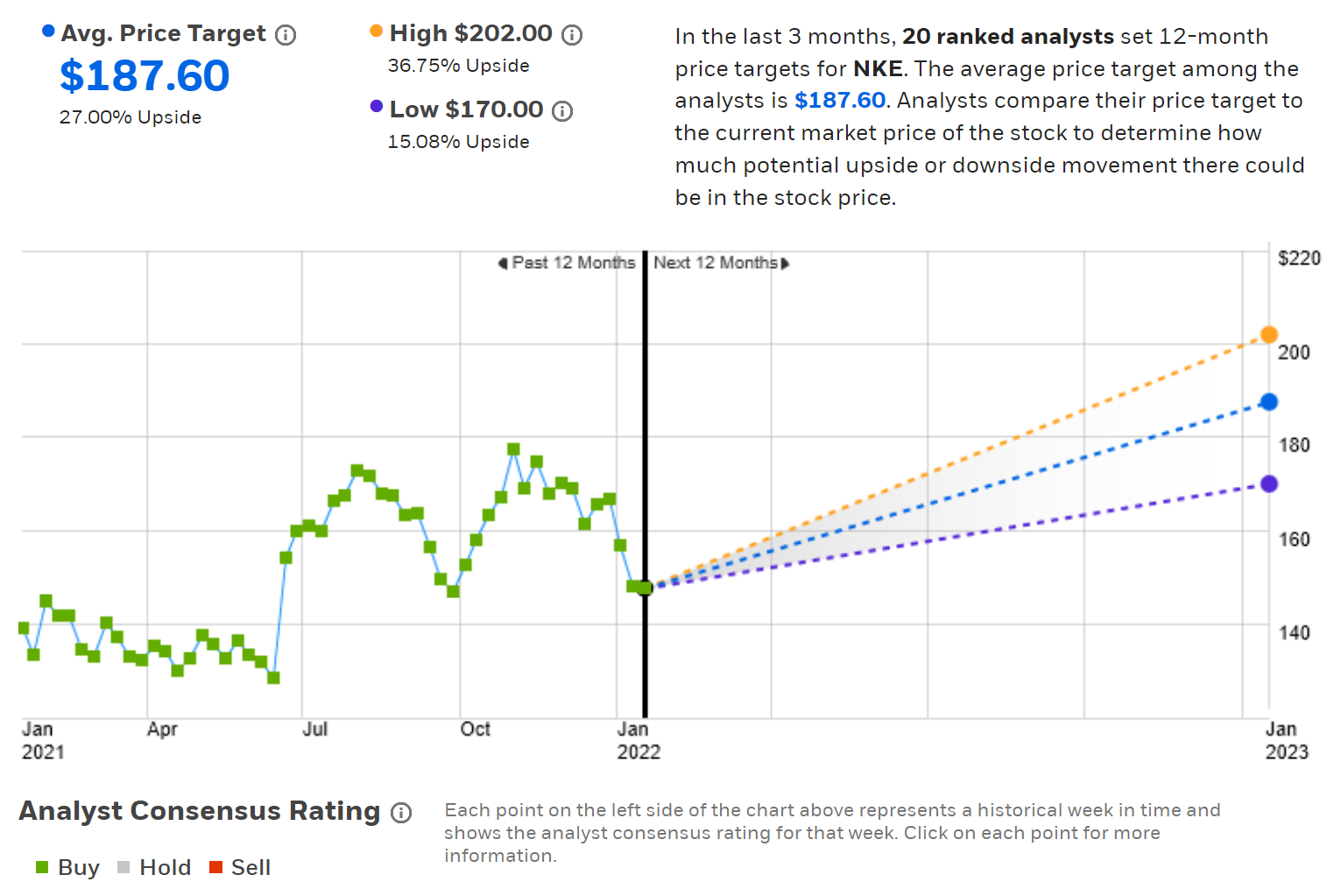
Source: E-Trade
Investing.com’s version of the Wall Street consensus outlook is calculated by aggregating the views of 35 analysts. The consensus rating is bullish and the consensus 12-month price target is 22.5% above the current share price, somewhat lower than E-Trade’s consensus value.

Source: Investing.com
Both the E-Trade and Investing.com calculations for the Wall Street consensus are bullish and both have consensus 12-month price targets that are above 22%, with an average of 24.7%.
Market-Implied Outlook for Nike
I generated market-implied outlooks for the next 1.9-months (using options that expire on Mar. 18, 2022), the next 4.9 months (using options that expire on June 17, 2022) and for the next 12.1 months (using options that expire on Jan. 20, 2023) to provide near-term views as well as through 2022. Options that expire in March, June, and January also tend to be very liquid, adding confidence in the meaningfulness of the market-implied outlook.
The standard presentation of the market-implied outlook is in the form of a probability distribution of price return, with probability on the vertical axis and return on the horizontal.
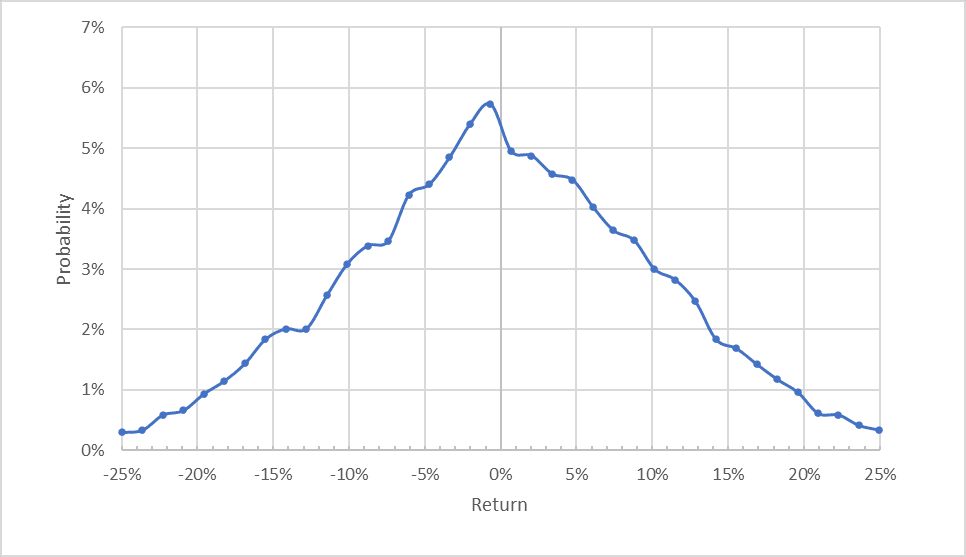
Source: Author’s calculations using options quotes from E-Trade
The market-implied outlook to Mar. 18 is very symmetric, although the peak in probability is very slightly tilted to favor negative returns. The annualized volatility calculated from this distribution is 32.4%, which is moderate for a large cap stock.
To make it easier to directly compare the probabilities of positive and negative returns, I rotate the negative return side of the distribution about the vertical axis (see chart below).
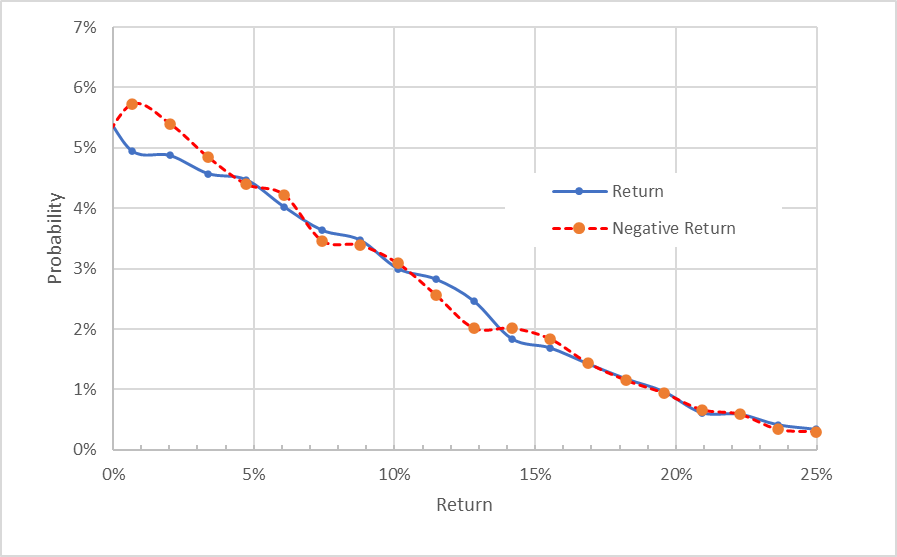
Source: Author’s calculations using options quotes from E-Trade. The negative return side of the distribution has been rotated about the vertical axis.
This view shows that the market-implied outlook is almost perfectly symmetric, with equal probabilities of positive and negative returns of the same magnitude (the red dashed line and the solid blue line are almost on top of each other).
Theory suggests that the market-implied outlook is expected to have a negative bias because risk-averse investors tend to overpay for downside protection (put options). The equity risk premium exists (theoretically) because investors demand to be compensated to bear risk (they are risk averse), so the assumption of a negative bias in the market-implied outlook is sensible. With that in mind, a neutral market-implied outlook (matching probabilities as we see here) should be interpreted as being (at least) slightly bullish.
Looking out to the middle of 2022, using options that expire on June 17, 2022, the market-implied outlook is similar and is also interpreted as being slightly bullish. The annualized volatility calculated using this outlook is 31.8%.
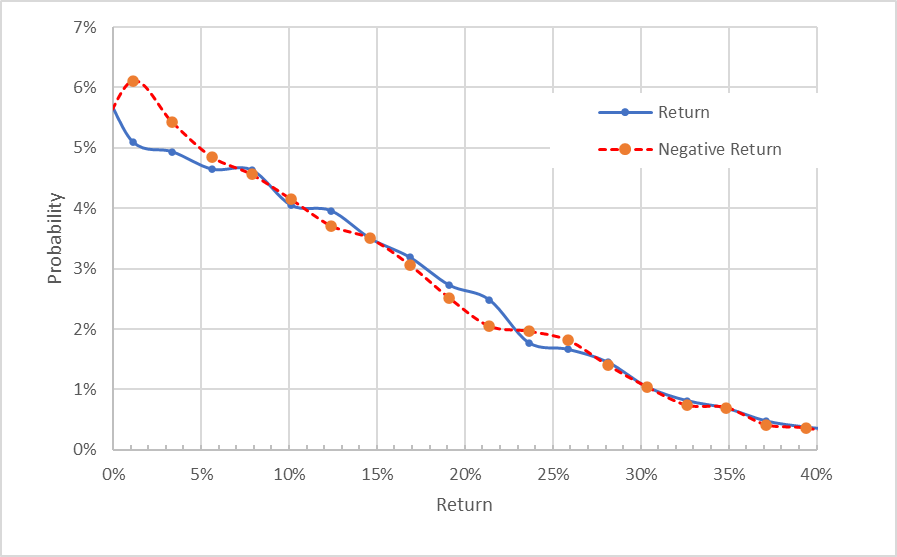
Source: Author’s calculations using options quotes from E-Trade. The negative return side of the distribution has been rotated about the vertical axis.
The market-implied outlook for the next year (calculated using options that expire on Jan. 20, 2023) shifts to increasingly favor negative price returns (the red dashed line is above the solid blue line over the left half of the chart). I interpret this outlook as slightly bearish. The annualized volatility calculated from this outlook is 31.8%.
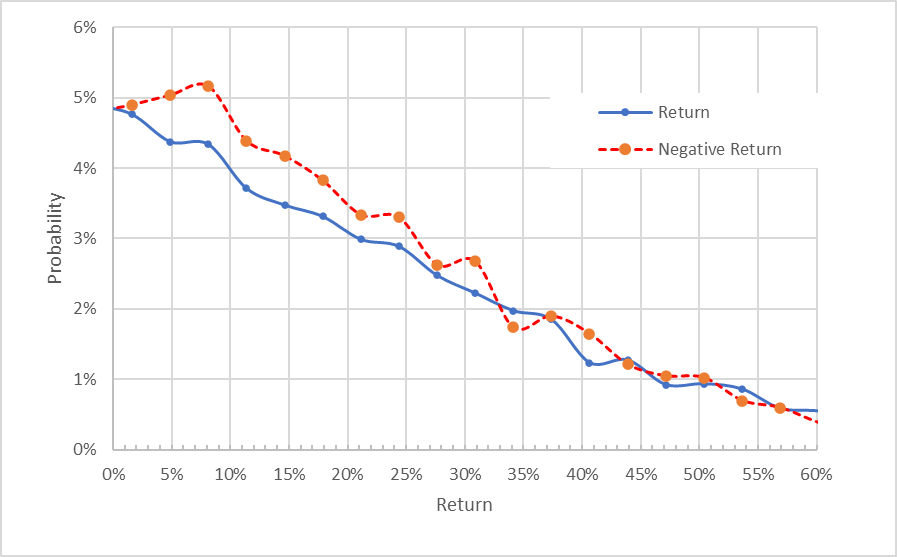
Source: Author’s calculations using options quotes from E-Trade. The negative return side of the distribution has been rotated about the vertical axis.
The market-implied outlooks for NKE are slightly bullish to mid-2022 but slightly bearish for the next 12 months. The expected volatility is stable through the year, at about 32%. My previous analysis, provided a (nearly) 11-month outlook for NKE that is qualitatively similar to the new 12.1-month outlook, although the current outlook has less of a bearish tilt.
Summary
In many ways, Nike is in a category of its own and, for this reason, peer comparisons are difficult. The shares are certainly expensive, but the P/E is well below highs from recent years.
Looking ahead, NKE increasingly focuses on the value of its design properties rather than on the utilitarian shoe business. The Wall Street analyst consensus rating is bullish and the consensus 12-month price target is 25% above the current share price. The market-implied outlook is slightly bullish to the middle of 2022, but slightly bearish for the full year. The expected volatility is about 32%.
As a rule of thumb for a buy rating, I look for an expected return that is at least half the expected volatility. The consensus for expected return from the analysts is far above this threshold. I am changing my rating on NKE from neutral to bullish, but I plan to revisit this analysis at mid-year.
